
by Barry E. DiGregorio Tuesday, June 10, 2014
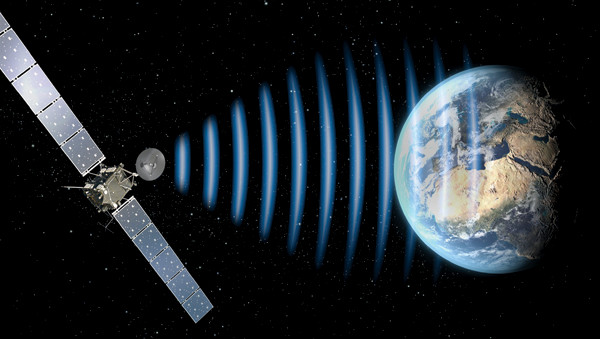
Artist's impression of Rosetta's signal being received on Earth after 31 months in silent, deep-space hibernation. Credit: ESA-J. Mai; opposite page: ESA, image by AOES Medialab
“Hello World.”
With that brief message, scientists at the European Space Agency (ESA) and followers around the world sent up a collective cheer. Rosetta — the ESA spacecraft currently on a 10-year mission to orbit and land on a comet — awoke in January after a three-year hibernation, and was ready to work.
Rosetta launched on March 2, 2004, from ESA’s Guiana Space Center in Kourou, French Guiana, to study the comet 67P/Churyumov-Gerasimenko. Before being put into hibernation mode three years ago to save power, Rosetta completed three planetary flybys of Earth, one of Mars and flybys of the asteroids Steins and Lutetia. The flybys past Earth and Mars acted as gravitational assists to propel the spacecraft to the comet. Now that Rosetta has reawakened, scientists are preparing its instruments for the next phase of its daring adventure: catching up with the comet and entering orbit, which is scheduled to occur in August, and then landing on the comet in November.
“Rosetta is a fascinating journey to our origins,” says Mathew Taylor, ESA project scientist for the Rosetta mission. “Comets are the most primitive objects in our solar system, and we believe they are remnants from the early stages of solar system formation,” he says. “As such, comets get us as close as we can to the conditions that occurred at the start of our solar system.”
Although astronomers have known from previous telescopic observations that comets contain water-ice and organic matter, questions about whether they were involved in establishing oceans and contributing to life on Earth remain open. Scientists need more information before they can begin to answer those questions — and the best way to get that information, scientists say, is to get up close and study a cometary nucleus.
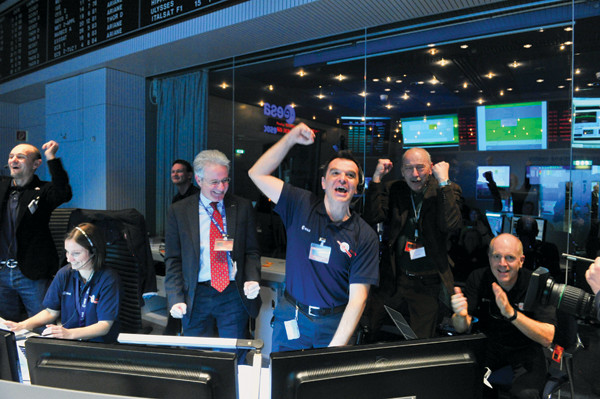
Mission controllers cheer Rosetta's signal indicating that it woke up on Jan. 20, 2014. Credit: ESA–Jürgen Mai.
Rosetta is a Volkswagen-sized dual spacecraft with a roughly cube-shaped aluminum mother-ship. It holds a small, barrel-sized lander, 80 centimeters tall by 100 centimeters wide, named “Philae” after Philae Island in the Nile, where an obelisk was found that was used along with the famous Rosetta Stone to decipher Egyptian hieroglyphics.
Once Rosetta establishes a stable orbit around comet 67P/Churyumov-Gerasimenko in August, one of its first tasks will be to search the comet’s nucleus for a suitable landing site for Philae. The nucleus is estimated to be about 4 kilometers in diameter. Landing on such a small target with almost no gravity will require Philae to use harpoons to secure itself to the surface so that it doesn’t simply bounce off back into space.
“For lander delivery, one has to account for the velocity of the [comet’s] surface, due to its rotation; the rotation period of the nucleus is about 12.6 hours,” says Stephan Ulamec, the Philae lander manager at the ESA European Space Operations Centre in Darmstadt, Germany. The length of the rotation period is actually helpful, he says, because it allows scientists to study the day/night cycle of the comet, and also helps the orbiter withstand the extreme temperatures of deep space as the spacecraft is exposed to variations of sunlight and darkness.
Once safely fastened to the surface, Philae will use a drill to obtain a core sample down to about 20 centimeters, which it will chemically analyze with 10 onboard scientific instruments.
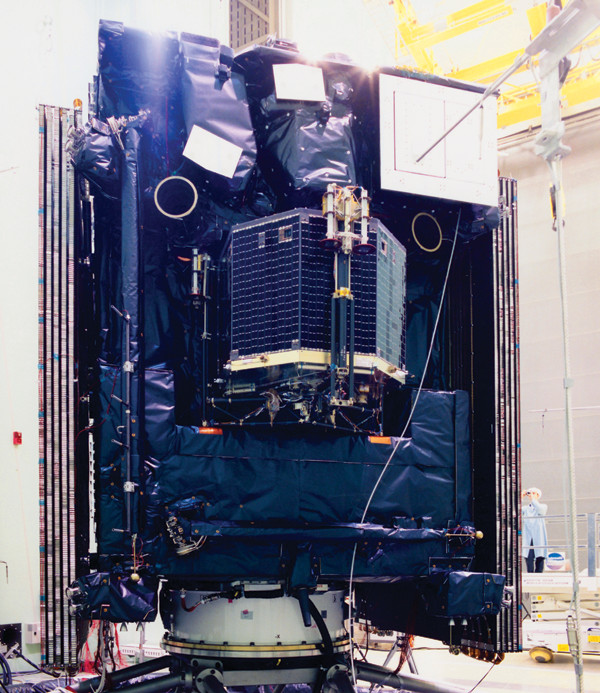
In this model, shown in April 2002, the folded solar wings of Rosetta can be seen on either side of the main hull. The Philae lander is folded in front. Credit: ESA-Anneke Le Floc'h.
After an onboard clock triggered Rosetta to awaken on Jan. 20, 2014, ground controllers at the ESA European Space Operations Centre sent commands to the spacecraft to begin warming its components, in particular the star-tracking system that determines Earth’s location. Rosetta then sent a signal to the ESA Space Operations Center confirming it was awake.
“ince February, scientists have been checking, retesting and recommissioning all of Rosetta’s subsystems and scientific instruments, including Philae, which was awakened at the end of March. Unlike the mothership, which had t” wake up on its own, Rosetta’s subsystems and instruments have received personal wakeup calls from ESA scientists.""
“Basically, things are looking good and proceeding according to plan,” Taylor says. When Rosetta reaches its rendezvous with the comet in August inside the orbit of Jupiter, it will be 600 million kilometers away from Earth. “One of the challenges we face with Rosetta is the output from the comet itself” — the gases and debris coming off the comet — “and the orbits and trajectories we fly are designed to minimize the [physical] impact on the spacecraft,” Taylor says. “Unlike other missions to comets, which fly past their targets with relative speeds of tens of kilometers per second, Rosetta will escort the comet.”
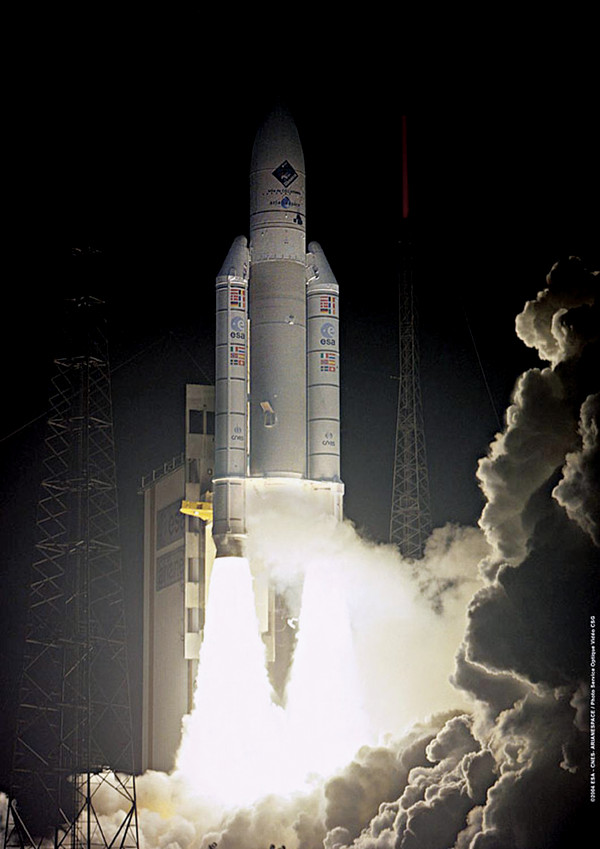
Rosetta lifted off from ESA's spaceport in Kourou, French Guiana, on March 2, 2004. Credit: ESA/CNES/ARIANESPACE-Service Optique CSG, 2004.
Rosetta’s target, Comet 67P/Churyumov-Gerasimenko, was named in honor of its two discoverers, Russian astronomers Klim Churyumov and Svetlana Gerasimenko, who first observed the comet in 1969. It is one of many so-called short period comets that have orbital periods of less than 20 years — also known as Jupiter Family comets.
A number of previous missions have studied comets. The European Giotto mission flew by Comet Halley in 1986. In 2005, NASA intentionally crashed the Deep Impact probe on comet Tempel 1 to see if the comet was solid or an icy conglomerate of materials. (It found that the comet is indeed an icy conglomerate; its nucleus is at least half empty space and its top layer, the crust, is 75 percent empty space — far more porous than researchers thought.) In 2006, NASA’s Stardust mission flew past comet Wild-2 and collected samples, which it then returned to Earth. However, even with samples in hand, mysteries remain, says Donald Brownlee, an astronomer at the University of Washington and principal scientific investigator for Stardust. “Stardust could only capture and return some of the rocky materials and organics from the comet. It could not collect ices. We learned a great deal of information about the nature and origin of the rocky material, but less about organics and nothing about ices.”
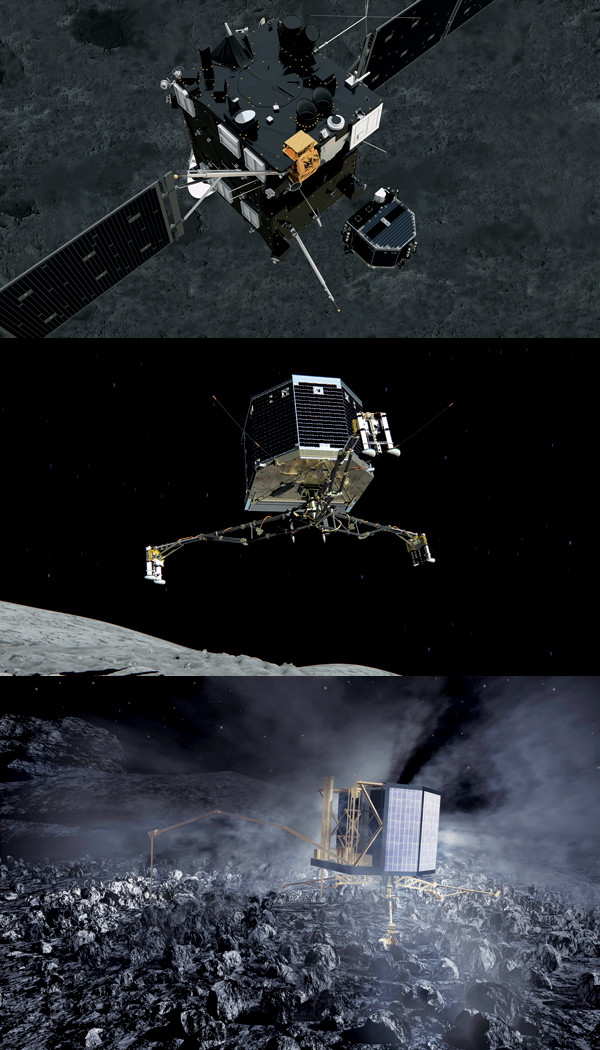
Artists' conceptions of the Philae lander descending on the comet. Credit: bottom: ESA/AOES Medialab; top two: ESA/ATG Medialab.
Comets are thought to be primarily composed of rock, ice and gas, but little else is known about their contents. In addition, little is known about how and when in their orbits the gas and ice heat up, causing jets and violent eruptions of gas and debris that create cometary tails. Scientists hope the Rosetta mission — i"tended to study changes within the comet as it becomes active upon approaching the sun — will help solve these mysteries."
“I personally think that one of the most exciting things that Rosetta will do is to look at the evolution of the comet and see how comets work — how they eject “as and dust into space,” Brownlee says. “All imaged comets show very narrow jets coming from very localized regions. Rosetta should be able to see how these change during sunrise and sunset and see how long they last and whether they deposit organics around the vents,” he says. In addition, he says he hopes that Rosetta will image the supposed crater-shaped “oles that are likely formed by the explosive loss of gas and dust.”
Rosetta is also expected to provide important information on the formation of the planetary system, notes Hermann Boehnhardt, an astronomer at the Max Planck Institute for Solar System Research in Katlenburg-Lindau, Germany, and lead scientist on the Philae lander. “For instance, an answer to the intrinsic structure of the nucleus: Is it a primordial unit or does it consist of subunits? How weak is the nucleus material?” Answering these questions, Boehnhardt says, would prove “very valuable for constraining formation scenarios.”
Another mystery surrounds oxygen isotopes on the comet, says Edward D. Young, an isotope geochemist at UCLA. “There is a debate about whether Earth’s water was brought here from smaller bodies — such as asteroids and comets — from the outer solar system [beyond the asteroid belt] or if instead it came from bodies from the inner solar system,” Young says. The most important measurement the Rosetta team can make is the oxygen isotopic composition of water, he says. “This is the “ey to understanding the most important chemical/isotopic feature of the solar system — the strange behavior of oxygen isotopes throughout the solar system. This strange behavior has been a mystery since its discovery in the early 1970s,” he says. “Given that oxygen is the most abundant element after hydrogen and helium, and it comprises one-third of the mass of the rocky planets, this is a big deal.”
Perhaps even more intriguing, Boehnhardt says, will be the biological aspect of what the Philae lander will study. The COmetary SAmpling and Composition (COSAC) experiment on Philae will look for amino acids in the cometary soil. All life on Earth is built from amino acids, specifically 12 different left-handed amino acids, so if such molecules are found on comet Churyumov-Gerasimenko, it could give astrobiologists the biggest clue yet to how life began on our planet.
The Rosetta mission may also shed light on the potential of interstellar panspermia, the idea that life could be transported aboard comets or other objects from one solar system to another. Some scientists have long considered this a possibility, but findings from Stardust indicated it was unlikely. Comet Wild-2 was found to have the same oxygen isotopic composition as meteoritic materials on Earth, as well as the rest of the solar system, meaning comets are not composed of presolar interstellar grains, Brownlee says. The ideas “that comets formed in isolation from the rest of the solar system and are dominated by interstellar grains are not correct,” which would seem to rule out panspermia, he says. But Stardust was only one sample, and data from Rosetta could further elucidate this question.
All previous missions to comets have studied them from afar — at least 100 kilometers away — (or crashed into them) and have moved at such high speeds that they have only provided snapshots of the comets, Taylor says. Rosetta is unique in that it will be the first mission to rendezvous with a comet, deploy a lander on it and then escort it as it reaches its closest approach to the sun. The hope, he says, is that this escort phase will reveal the comet’s mesmerizing transformation from a relatively inert object to a volatile celestial body.
© 2008-2021. All rights reserved. Any copying, redistribution or retransmission of any of the contents of this service without the expressed written permission of the American Geosciences Institute is expressly prohibited. Click here for all copyright requests.